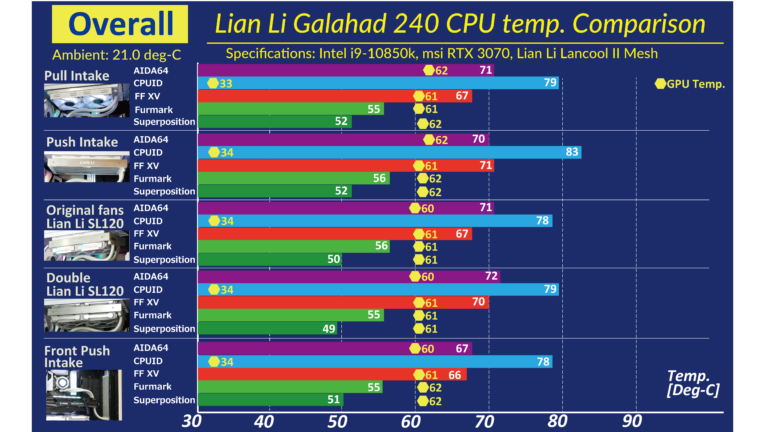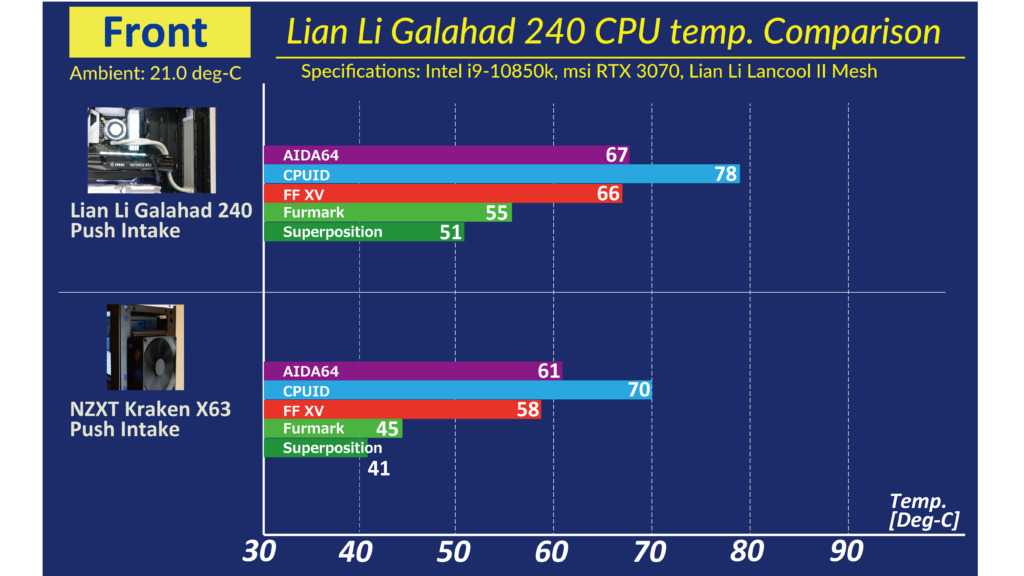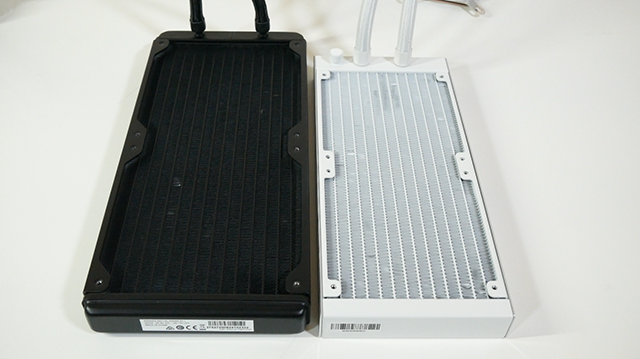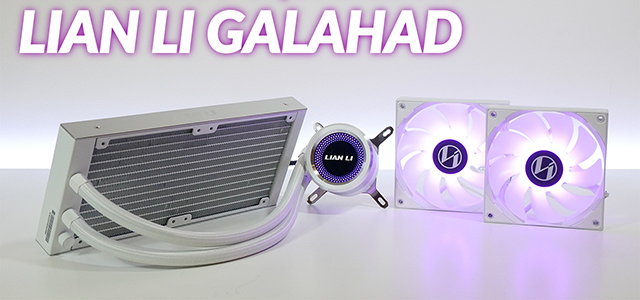We unboxed Lian Li Galahad 240 AIO Cooler and find out the best AIO orientations, fan configurations, and specification comparisons with NZXT Kraken X63, a 280mm AIO cooler.
In our previous video, we had unveiled a cooling performance on the NZXT Kraken X63.
We will utilize the same PC for the comparison, which the PC case as a Lian Li Lancool II Mesh, Intel i9-10850k, and MSI RTX 3070.
Since the CPU is i9 and the GPU is RTX3070, I consider measuring the CPU temperature data on intake.
Also, we have done experiments on installing four 120mm cooling fans on the 240mm AIO radiator to find out if it’s the right solution.

The Lian Li Galahad pump is not supplied from the Asetek. The triple chamber pump structure is quite similar to Cooler Master’s Dual Chamber Pump.
Fan model number is GF.12F19P.R50B0.
The fan is PWM and the rotational speed is between 800 and 1800 rpm (+/- 10%).
The catalog spec airflow is 65.53 CFM, and the noise level is 30.1dB (A).
The fan is ARGB, and the quality is reasonable.

Left: Galahad Enclosed GF.12F19P.R50B0 120mm ARGB fan
Right: Uni Fan SL120
The build quality is excellent. And we can enjoy the authentic design on both black and white editions. The hairline-designed aluminum radiator cover shows a good presentation. 12 tube pipes on the radiator. Also, the refilling port is on the radiator. Lian Li should cover the radiator with a carton box like NZXT.

We took benchmarks on CPUID, Final Fantasy XV, Furmark, Aida64, and Superposition.
The AIO orientations are on the top and front, and the airflow is intaking ambient air inside the PC case. So, when we install the AIO on the top, I need to attach a magnetic air filter.
We measured the push intake, the pull intake, also, mounted four fans for both the push and pull. We measured two ways for the double fans, which installed original fans on the push side, Lian Li Uni Fan SL120 on the Pull side. And both the SL120 on the push and pull side to see if it makes a difference. Also, we made comparisons with NZXT Kraken X63 280mm AIO to see the differences in the radiator size on the front side.

Comparing the pull intake and the push intake, I expected the push intake would cool better than the pull intake. Because through my experiments, push towards the radiator would pass more air. In other words, the push generates more airflow than the pull. But the result was the pull intake cools better than push intake. Significantly, the CPUID and Final Fantasy XV, which the CPU heavy loading bench software, showed 4 degrees differences. The 4 degrees is quite a big gap.
For the double-sided fan orientations, there were not that many differences with the single side fans.
Lian Li Lancool II applies a fine mesh filter on the top. When airflow passes the mesh filter, the airflow generates the turbulence layer. In this case, the position of the fan is crucial. In our previous video on the Lian Li Lancool II Mesh Review, I found a certain clearance is needed between the filter and the fan for efficient airflow. The mesh filter and the fan on the Lian Li Lancool II on the top are very close together. So, that might be the reason.

the AIO on the front should cool better than the top. I will show you the overall comparison next, but the front side was the best cooling position out of the five. The difference was quite surprising by comparing the Galahad 240 with NZXT Kraken X63, 280mm AIO. The temperature difference was 6 to 10 degrees-C.
Galahad 240’s surface area is 288 cm2, while the X63 is 392 cm2. So the difference is 26.5%. Moreover, comparing the 120mm and 140mm fans, 140mm fans will deliver more air. So, I was expecting more temperature differences. The fact shows the Galahad 240 has an excellent cooling performance. The overall comparison shows the AIO on the front is the best option. The maximum temperature difference is 5 degrees-C on CPU ID and Final Fantasy XV. I installed the AIO radiator vertically with rubber hose to be downward. In general, AIO coolant liquid filled between 70 and 90 percent of its capacity while manufacturing. So certain air remains inside the AIO. If the air remains inside the pump, the performance drops. Also, if the AIO radiator is installed vertically with coolant inlet and outlet to be upward, and if they are the highest, the air remains on the inlet and outlet port on the AIO. It would make noise also the performance might drop.
So, I recommend installing the AIO rubber hose to be downward for the vertical orientation. It would last your AIO longer.

Left: NZXT Kraken X63 280mm Radiator
Right: Lian Li Galahad 240mm Radiator
The maximum fan speed is 1800rpm. When it comes to full speed, the noise level is relatively high. An only small request to Lian Li, the refilling port collides with the Lancool II fan bracket. If it moves 2mm towards the hose side, it would be perfect.
Lian Li keeps evolving since its establishment. Their philosophy matches with customer’s enthusiasm, and it’s not only the marketing or R&D. I believe it is the reason why people love their products.
Overall, the build quality is good, and it cools enough on i9-10850k with CPU overclock.
It’s worth to buy, and you will get what you paid for.
➤➤➤ Subscribe YouTube: https://cutt.ly/N-Tech-Labo
➤➤➤Here are more exclusive tech content:
➤Lian Li Lancool II Mesh Build: https://youtu.be/9sywQDXORf4
➤Lian Li Lancool II Mesh Review: https://www.youtube.com/watch?v=1sJjAE95Vww
➤NZXT Kraken X63 Review: https://youtu.be/7Tsk3HDTZRc
➤➤➤Music by us: https://cutt.ly/M_Tech_Music

